Optimization of Return Channels of High Flow Rate Centrifugal Compressor Stages Using CFD Methods
Abstract
:1. Introduction
- -
- Maximum thickness .
- -
- Leading edge radius .
- -
- Trailing edge radius .
2. Materials and Methods
- -
- In the grid generator TurboGrid (ANSYS 2019 R3, ANSYS Inc., Canonsburg, PA, USA ), computational grids were built separately for vanes and splitter vanes. The total number of elements was 398,000.
- -
- In the CFX-Pre program, the computational grids were combined into one area, consisting of two vanes and one splitter vane (Figure 10).
- -
- The values y+ < 2 (dimensionless height of the first boundary element) in 98% of the bounding surfaces’ area. In several problematic areas (about 2%), y+ values reached 20. In both cases this values meet the requirements of correct modeling of the boundary layer using the SST (Shear-Stress-Transport) turbulence model.
- -
- Total pressure , total temperature and a flow angle were set at the inlet.
- -
- The mass flow rate was set at the outlet.
3. Results
3.1. Return Channel Variants of the Stages with a flow rate of 0.15, a Loading Factor of 0.45
3.2. Stage with a Vane Number Ratio of 0.69. U-Bend Optimization
3.3. Return Channel Variants of the Stages with a Flow Rate of 0.15, a Loading Factor of 0.60
3.4. Return Channel Variants of the Stages with a Flow Rate of 0.15, a Loading Factor of 0.70
3.5. Characteristics of the Return Channels of Stages with Different Loading Factors
4. Discussion
5. Conclusions
Author Contributions
Funding
Conflicts of Interest
Abbreviations
| Nomenclature | |
| vane height; | |
| absolute flow velocity; | |
| diameter; | |
| length; | |
| mass flow rate; | |
| impeller Mach number; | |
| pressure; | |
| gas constant, curvature radius; | |
| temperature; | |
| impeller blade velocity; | |
| number of vanes; | |
| flow angle with respect to tangent; | |
| vane angle with respect to tangent; | |
| vane thickness; | |
| efficiency; | |
| loading factor; | |
| loss coefficient; | |
| gas density; | |
| relative flow rate coefficient. | |
| Abbreviation | |
| CFD | Computational Fluid Dynamics; |
| MOGA | Multi-Objective Genetic Algorithm; |
| Q3D | Quasi-three-dimensional; |
| RCh | return channel |
| Subscripts | |
| 2, 3, 4, 5, 6, 0’ | indices of control sections; |
| av | average; |
| cr | critical; |
| des | design; |
| h | hub; |
| inl | inlet; |
| LE | leading edge; |
| OPT | optimized; |
| ORG | original; |
| out | outlet; |
| pr | vane pressure side; |
| s | shroud, vane suction side; |
| TE | trailing edge; |
| ub | U-bend; |
| v | vane. |
| Superscripts | |
| * | stagnation parameters; |
| – (superscript) | related to or ; |
| ~ (superscript) | related to |
References
- Galerkin, Y.B. (Ed.) Proceedings of the Scientific School of Compressor Engineering SPbSPU; Publishing House of Scientific and Technical Information Center—SPb: Alexandria, VA, USA, 2010. [Google Scholar]
- Vasiliev, Y.S.; Rodionov, P.I.; Sokolovsky, M.I. New generation highly efficient centrifugal compressors. Scientific bases of calculation, development of methods for optimal design and production development. Ind. Sci. Russ. 2000, 10, 78–85. [Google Scholar]
- Galerkin, Y.B.; Danilov, K.A.; Popova, E.Y. Universal Modelling for Centrifugal Compressors-Gas Dynamic Design and Optimization Consepts and Application. In Proceedings of the Yokohama International Gas Turbine Congress, Yokohama, Japan, 22–27 October 1995. [Google Scholar]
- Galerkin, Y.; Danilov, K.; Popova, E. Design philosophy for industrial centrifugal compressor. In Inernational Conference on Compressors and Their Systems; City University: London, UK, 1999; pp. 465–480. [Google Scholar]
- Galerkin, Y.B. Turbocompressors. Workflow, Calculation and Design of the FLOW PATH; LLC “Information and Publishing Center” KHT: Moscow, Russia, 2010; p. 596. [Google Scholar]
- Galerkin, Y.B.; Rekstin, A.F. Vaneless diffuser of the centrifugal compressor stage design method. AIP Conf. Proc. 2019, 2141, 030007. [Google Scholar] [CrossRef]
- Rekstin, A.F.; Galerkin, Y.B. The primary design method development of centrifugal compressor impellers based on the analysis of the geometrical parameters. Oil Gas Eng. AIP Conf. Proc. 2019, 2141, 030052. [Google Scholar] [CrossRef]
- Solovyeva, O.; Drozdov, A. Mathematical model of centrifugal compressor vaneless diffuser based on CFD calculations. In Proceedings of the 2nd International Conference on High Speed Turbomachines and Electrical Drives (HSTED-2020)—E3S Web of Conferences, Prague, Czech Republic, 14–15 May 2020; EDP Sciences: Les Ulis, France, 2020; Volume 178, p. 01014. [Google Scholar]
- Rekstin, A.F.; Galerkin, Y.B. Low-flow rate centrifugal compressor stages primary design specificity. Bull. Perm Natl. Res. Polytech. Univ. 2018, 20, 43–54. [Google Scholar] [CrossRef]
- Rube, C.; Rossbach, T.; Wedeking, M.; Grates, D.R.; Jeschke, P. Experimental and Numerical Investigation of the Flow Inside the Return Channel of a Centrifugal Process Compressor. In Proceedings of the Turbine Technical Conference and Exposition, Montreal, ON, Canada, 15–19 June 2015; Volume 138, p. 101006-1. [Google Scholar] [CrossRef]
- Bisping, J.; Rossbach, T.; Grates, D.; Hildebrandt, A.; Jeschke, P. Influence of Diffuser Diameter Ratio on the Performance of a Return Channel Within A Centrifugal Compressor Stage. In Proceedings of the GPPS Forum 18 Global Power and Propulsion Society, Montreal, ON, Canada, 7–9 May 2018. [Google Scholar]
- Yagi, M.; Nishioka, T.; Kobayashi, H.; Nishida, H.; Yamamoto, S. Effects of return channel with splitter vanes on performance of multistage centrifugal compressor. In Proceedings of the Turbine Technical Conference and Exposition GT2015, Montreal, QC, Canada, 15–19 June 2015. [Google Scholar]
- Nishida, Y.; Kobayashi, H.; Nishida, H.; Sugimura, K. Performance improvement of a return channel in a multistage centrifugal compressor using multiobjective optimization. J. Turbomach. 2013, 135, 031026–310268. [Google Scholar] [CrossRef] [PubMed] [Green Version]
- Ji, C.; Li, C.; Fang, J.; Sun, Q. Loss Mechanism of Static Interstage Components of Multistage Centrifugal Compressors for Integrated Blade Design. Math. Probl. Eng. 2018, 16. [Google Scholar] [CrossRef]
- Veress, A.; Van den Braembussche, R. Inverse design and optimization of a return channel for a multistage centrifugal compressor. J. Fluids Eng. 2004, 126, 799806. [Google Scholar] [CrossRef]
- Jariwala, V.; Larosiliere, L.; Hardin, J. Design Exploration of a Return Channel for Multistage Centrifugal Compressors. In Proceedings of the ASME Turbo Expo 2016: Turbomachinery Technical Conference and Exposition GT2016, Seoul, Korea, 13–17 June 2016. [Google Scholar]
- De Bellis, F.; Guidotti, E.; Rubino, D.T. Centrifugal compressors return channel optimization by means of advanced 3D CFD. In Proceedings of the Turbine Technical Conference and Exposition GT2015, Montreal, QC, Canada, 15–19 June 2015. [Google Scholar]
- Hildebrant, A. Aerodynamic optimization of a centrifugal compressor return channel and U-turn with Genetic Algorithms. In ASME Turbo Expo 2011; ASME Paper GT201145067; ASME: New York, NY, USA, 2011. [Google Scholar]
- Hildebrandt, A. Numerical analysis of overall performance and flow phenomena of an automatically optimized treedimensional return channel system for multistage centrifugal compression systems. In ASME Turbo Expo 2012; ASME Paper GT2012-68559; ASME: New York, NY, USA, 2012. [Google Scholar]
- Marenina, L.; Galerkin, Y.; Drozdov, A. Stator elements optimization of centrifugal compressor intermediate type stage by CFD methods. In Proceedings of the 2nd International Conference on High Speed Turbomachines and Electrical Drives (HSTED-2020)—E3S Web of Conferences, Prague, Czech Republic, 14–15 May 2020; EDP Sciences: Les Ulis, France, 2020; Volume 178, p. 01020. [Google Scholar] [CrossRef]
- Kortikov, N.; Borovkov, A.; Voynov, I.; Kirillov, A.; Drozdov, A. Modeling the gas-dynamic characteristics of the low-flow and mid-flow model stages for an industrial centrifugal compressor. In Proceedings of the MATEC Web of Conferences, Saint-Petersburg, Russia, 5 December 2018; Volume 245, p. 04019. [Google Scholar]
- Borovkov, A.I.; Voinov, I.B.; Nikitin, M.A.; Galerkin, Y.B.; Rekstin, A.F.; Drozdov, A.A. Experience of performance modeling the single-stage pipeline centrifugal compressor. Oil Gas Eng.-AIP Conf. Proc. 2019, 2141, 030051. [Google Scholar] [CrossRef]
- Borovkov, A.I.; Voinov, I.B.; Galerkin, Y.B.; Drozdov, A.A.; Soldatova, K.V. Experimental characteristic simulation for two-stage pipeline centrifugal compressor. IOP Conf. Ser. Mater. Sci. Eng. 2019, 604, 012052. [Google Scholar] [CrossRef]
- Borovkov, A.; Voinov, I.; Galerkin, Y.; Nikiforov, A.; Nikitin, M.; Solovyeva, O.; Kabalyk, K. Issues of gas dynamic characteristics modeling: A study on a centrifugal compressor model stage. In Proceedings of the E3S Web of Conferences—International Scientific Conference on Energy, Environmental and Construction Engineering (EECE-2019), St. Petersburg, Russia, 19–20 November 2019; EDP Sciences: Les Ulis, Franc, 2019; Volume 140, p. 06003. [Google Scholar] [CrossRef] [Green Version]
- Galerkin, Y.B.; Rekstin, A.F.; Marenina, L.N.; Soldatova, K.V. Creation of parametrized model of return channel flow path for CFD-researches. In Proceedings of the Technique and tecHnology of Petrochemical and Oil and Gas Production—Materials of the 10th International Scientific and Technical Conference, Omsk, Russia, 26–29 February 2020; Publishing House of OmGTU: Omsk, Russia, 2020; pp. 127–128. [Google Scholar]
- Ries, V.F. Centrifugal Compressor Machines; Leningrad Branch: Moscow, Russia, 1981; p. 351. [Google Scholar]
- Den, G.N. The Mechanics of the Flow in Centrifugal Compressors; Mashinostroenie: Leningrad, Russia, 1973; p. 269. [Google Scholar]
- Livshits, S.P. Aerodynamics of Centrifugal Compressor Machines/SP Livshits; Mechanical Engineering: Leningrad, Russia, 1966; 340p, pp. 335–337. [Google Scholar]
- Seleznev, K.P.; Galerkin, Y.B. Centrifugal Compressors, L. Mechanical Engineering; Leningrad department: Saint Petersburg, Russia, 1982. [Google Scholar]
- Aungier, R.H. Centrifugal Compressors: A Stragedy for Aerodynamic Design and Analysis; Ronald, H.A., Ed.; ASME Press: New York, NY, USA, 2000; p. 320. [Google Scholar]
- Cumpsty, N.A. Compressor Aerodynamics; Longman Scientific and Technical: London, UK, 1989; 509p. [Google Scholar]
- Drozdov, A.; Rekstin, A. Analysis of the velocity diagrams of impellers of centrifugal compressor stages after the preliminary design. In Proceedings of the MATEC Web of Conferences, Saint-Petersburg, Russia, 5 December 2018; Volume 245, p. 04004. [Google Scholar] [CrossRef]
- Popova, E.Y. Optimization of the Main Parameters of Stages of Turbomachines Based on Mathematical Modeling. Ph.D. Thesis, Tech. SPbSPU, St. Petersburg, Russia, 1991. [Google Scholar]
- Rekstin, A.F.; Soldatova, K.V.; Galerkin, Y.B. Experience of application the computer program based on a simplified mathematical model for industrial centrifugal compressors candidates. IOP Conf. Series: Mater. Sci. Eng. 2019, 604, 012045. [Google Scholar] [CrossRef]
- Rekstin, A.F.; Soldatova, K.V.; Galerkin, Y.B.; Popova, E.Y. Verification of a simplified mathematical model of centrifugal compressor stages. In Proceedings of the International Scientific and Technical Conference Smart Energy Systems, SES 2019, Kazan, Russia, 19–20 September 2019; EDP Sciences: Les Ulis, France, 2019; Volume 124, p. 01005. [Google Scholar] [CrossRef] [Green Version]
- Rekstin, A.F.; Bakaev, B.V. Variant calculations of industrial centrifugal compressors based on a simplified mathematical model. // Scientific and technical statements of SPbSTU. Nat. Eng. Sci. 2018, 24, 24–38. [Google Scholar] [CrossRef]
- Sorokes, J.M.; Hutchinson, B.R. The Practical Application of CFD in the Design of Industrial Centrifugal Compressors. In Proceedings of the ASME International Mechanical Engineering Congress and Exposition, Challenges and Goals in Pipeline Compressors, Orlando, FL, USA, 5–10 November 2000. [Google Scholar]
- Galerkin, Y.; Rekstin, A.; Drozdov, A.; Soldatova, K.; Solovyeva, O.; Popova, E. The optimal gas dynamic design system of industrial centrifugal compressors based on Universal modeling method. In Proceedings of the 2nd International Conference on High Speed Turbomachines and Electrical Drives (HSTED-2020)—E3S Web of Conferences, Prague, Czech Republic, 14–15 May 2020; EDP Sciences: Les Ulis, France, 2020; Volume 178, p. 01028. [Google Scholar] [CrossRef]
- Galerkin, Y.B.; Marenina, L.N. Investigation and perfection of centrifugal compressor stages by CFD methods. Part 1. Compressors and pneumatics. In. J. Ind. Manuf. Eng. 2014, 1, 30–36. [Google Scholar]
- Marenina, L.; Galerkin, Y.; Soldatova, K. Computational fluid dynamics application for analysis of centrifugal compressor stage stator part. Int. J. Mech. Eng. Robot. Res. 2018, 7, 656–661. [Google Scholar] [CrossRef]
- Solovyeva, O. Mathematical Model for Gas-Dynamic Characteristics Calculation and Optimization of Vaneless Diffusers of Centrifugal Compressor Stages. Ph.D. Thesis, Tech. SPbSPU, Saint-Petersburg, Russia, 2018; p. 162. [Google Scholar]
- Rekstin, A.F.; Drozdov, A.A.; Solovyova, O.A.; Galerkin, Y.B. Comparison of two mathematical models of a vaneless diffuser of a centrifugal compressor stage. Compress. Pneum. 2019, 1, 2–10. [Google Scholar]
- Luke, S. Essentials of Metaheuristics. A Set of Undergraduate Lecture Notes; Lulu.com: Cedar Fork, NC, USA, 2009. [Google Scholar]
- Yoshimura, M.; Misaka, T.; Shimoyama, K.; Obayashi, S. Topology Optimization of Flow Channels with Heat Transfer Using a Genetic Algorithm Assisted by the Kriging Model. In Advances in Evolutionary and Deterministic Methods for Design, Optimization and Control in Engineering and Sciences, Computational Methods in Applied Sciences; Springer International Publishing AG: Berlin, Germany, 2019; Volume 48. [Google Scholar] [CrossRef]
- Luo, C.; Shimoyama, K.; Obayashi, S. A Study on Many-Objective Optimization Using the Kriging-Surrogate-Based Evolutionary Algorithm Maximizing Expected Hypervolume Improvement. Math. Probl. Eng. 2015, 15. [Google Scholar] [CrossRef] [Green Version]
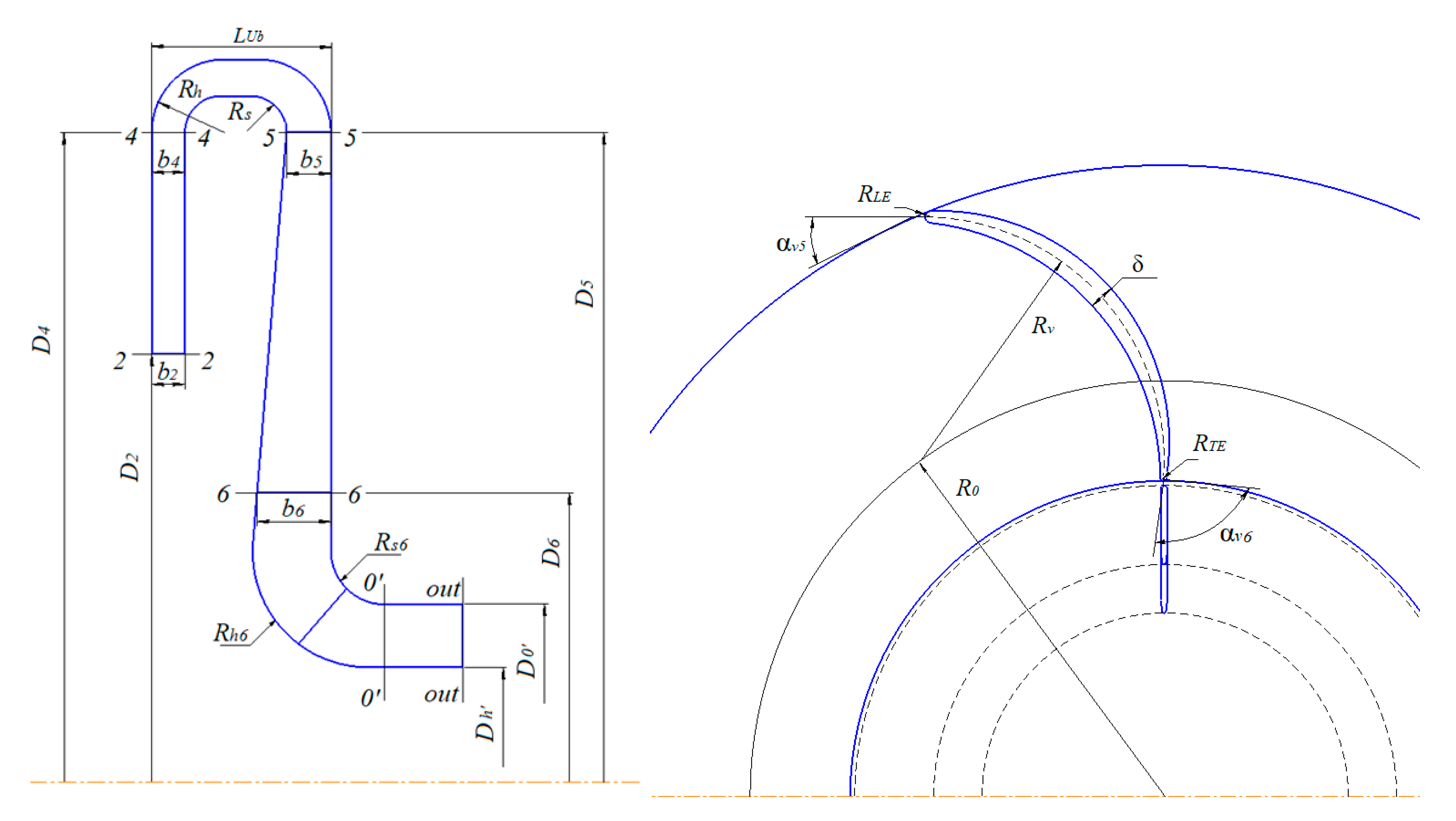


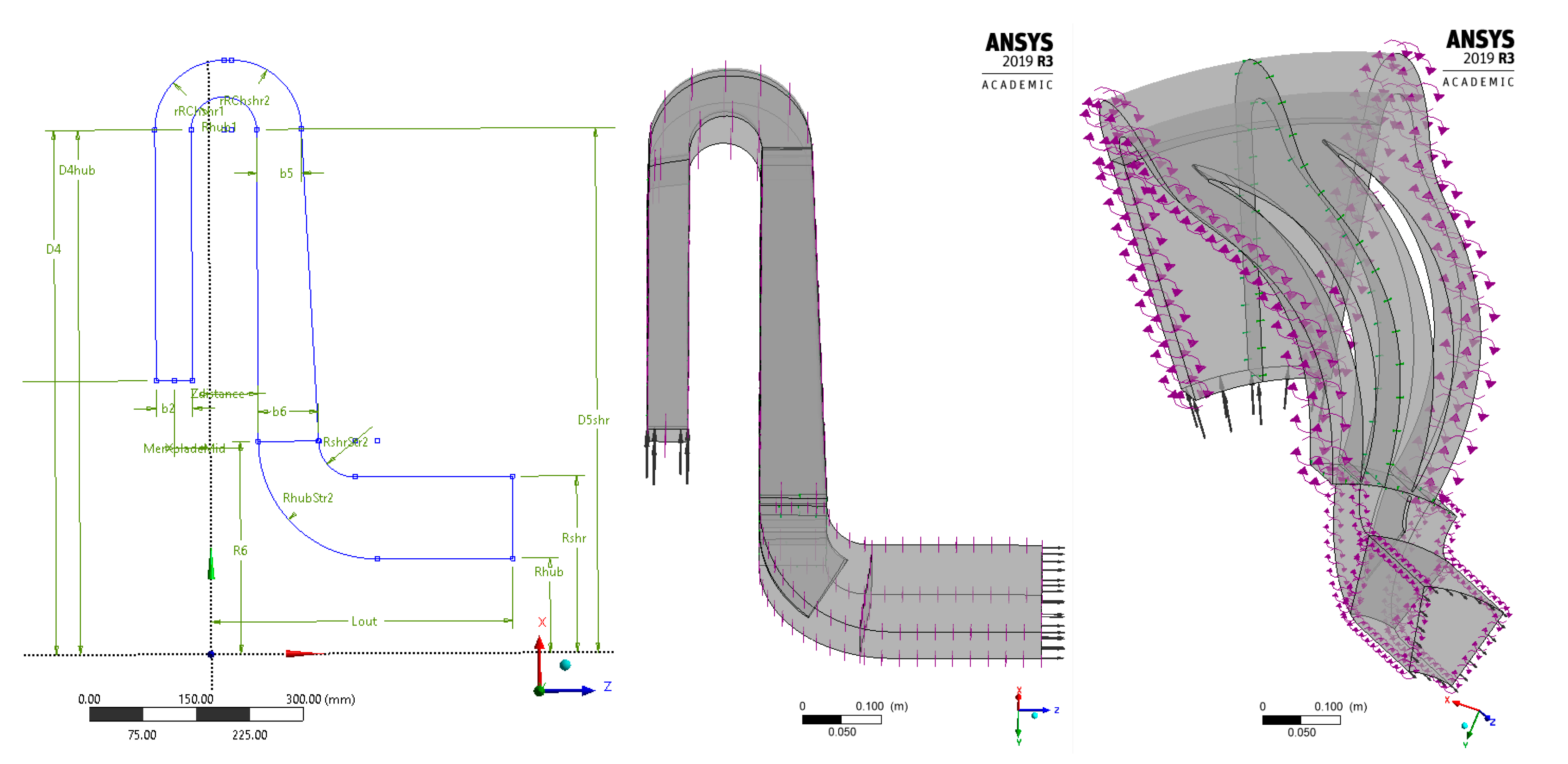

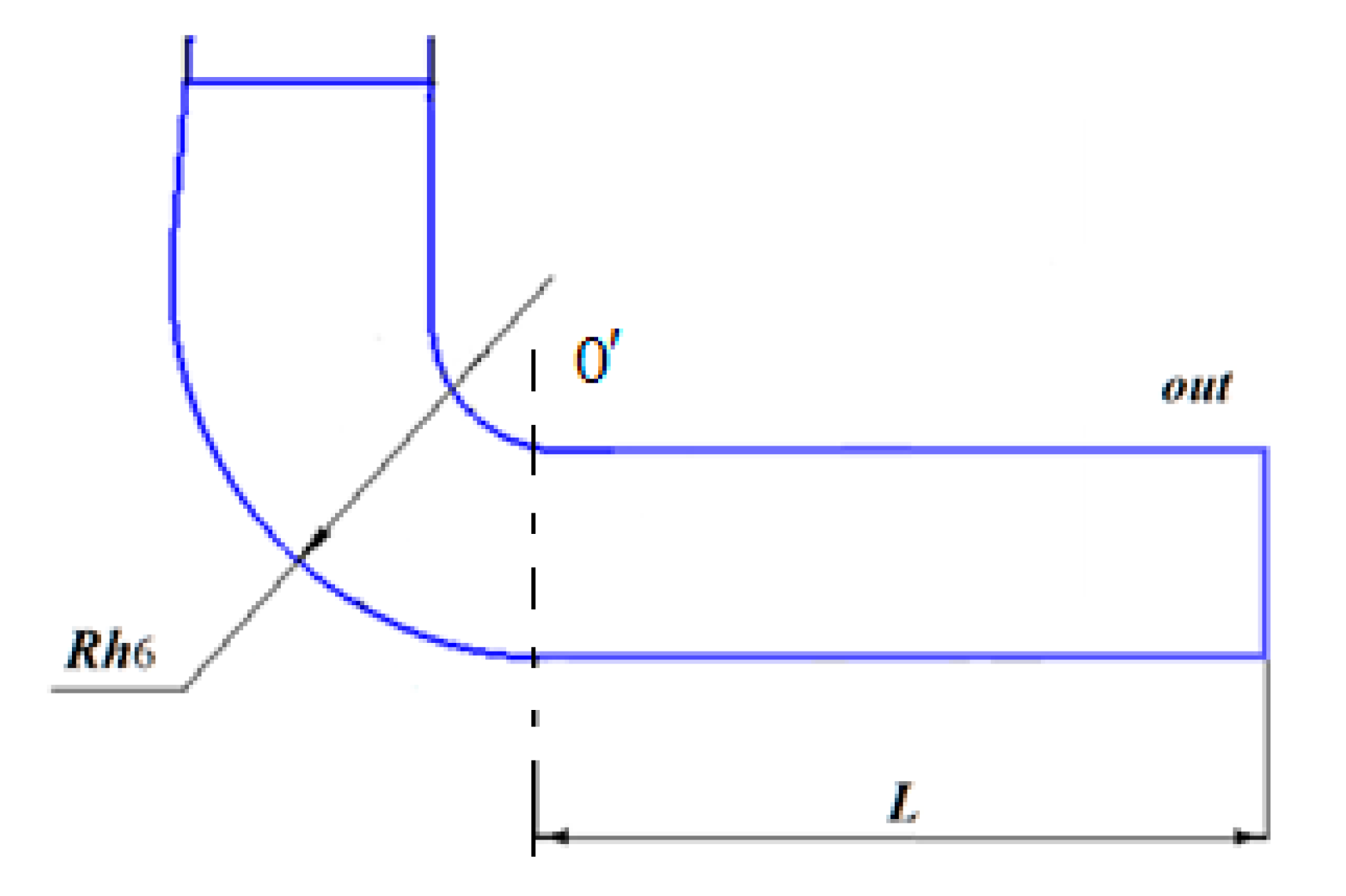
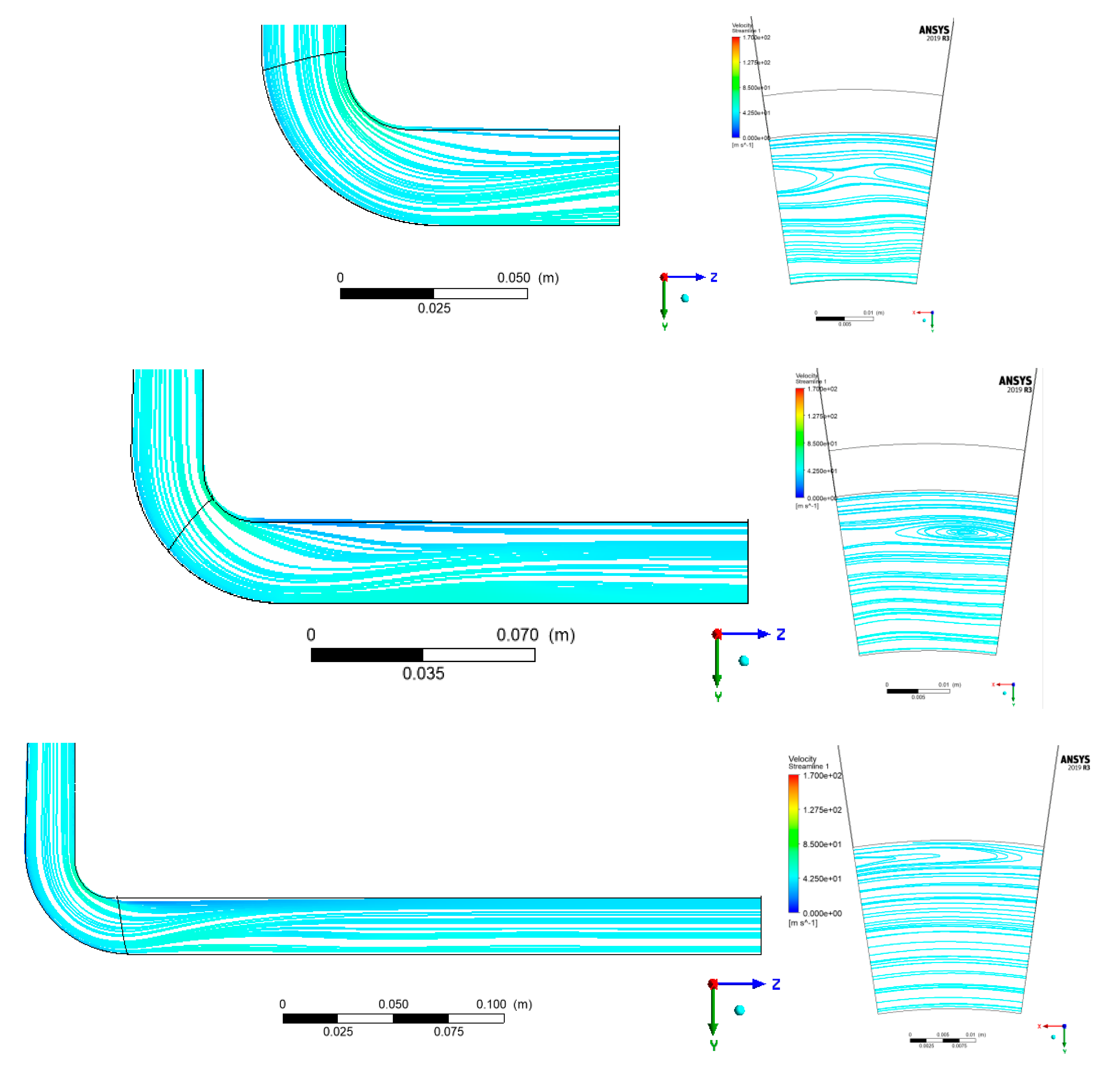
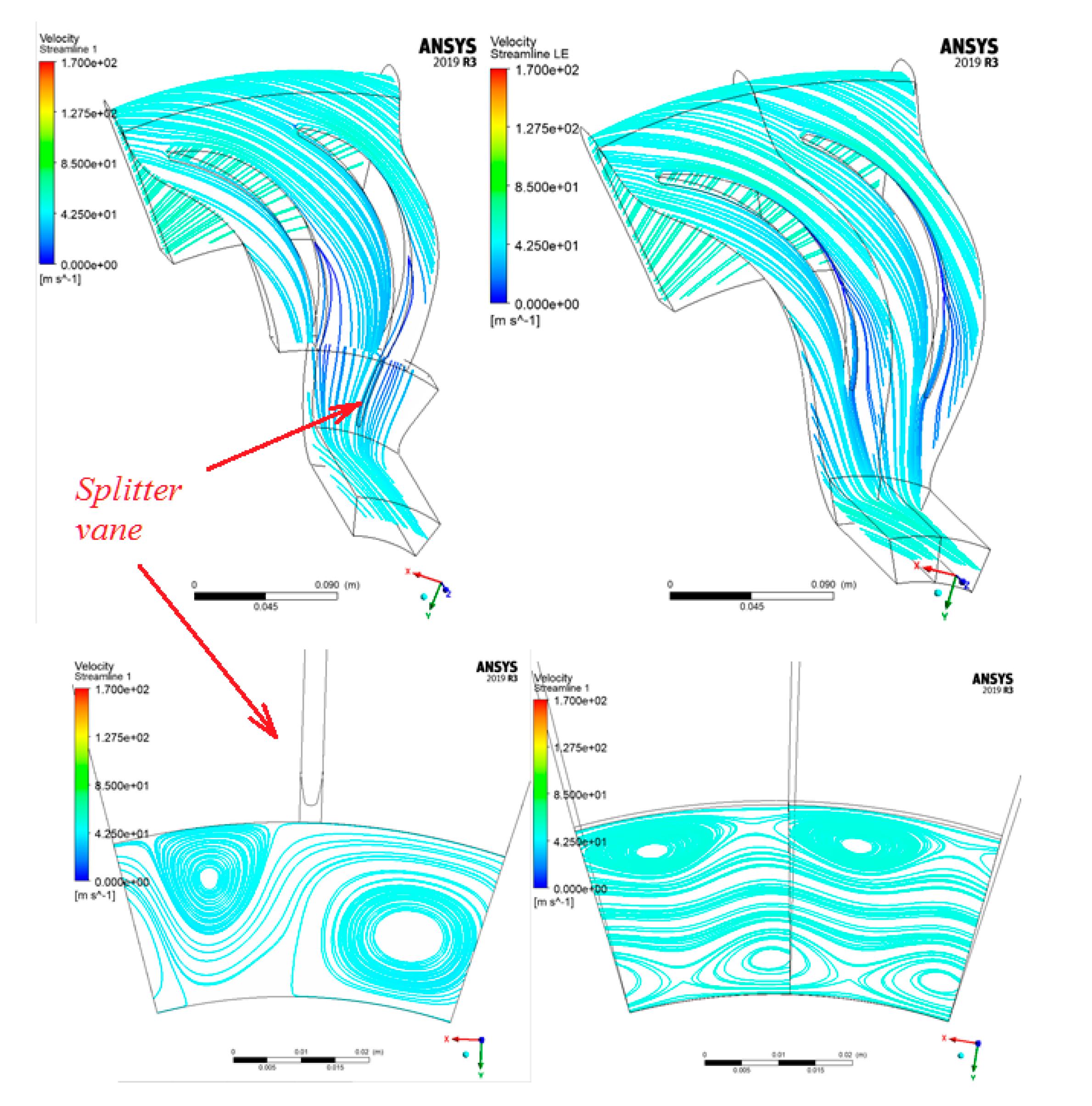


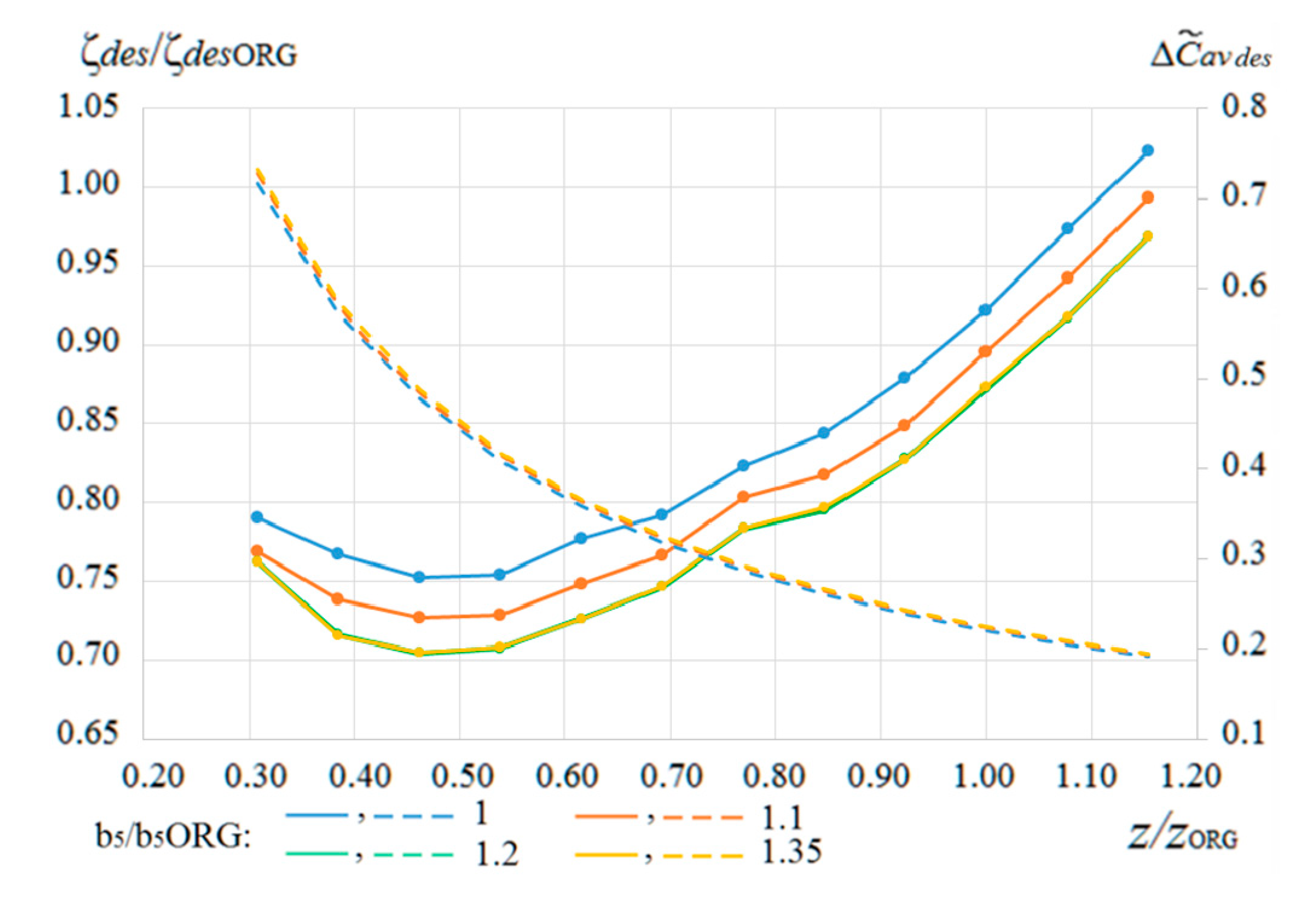

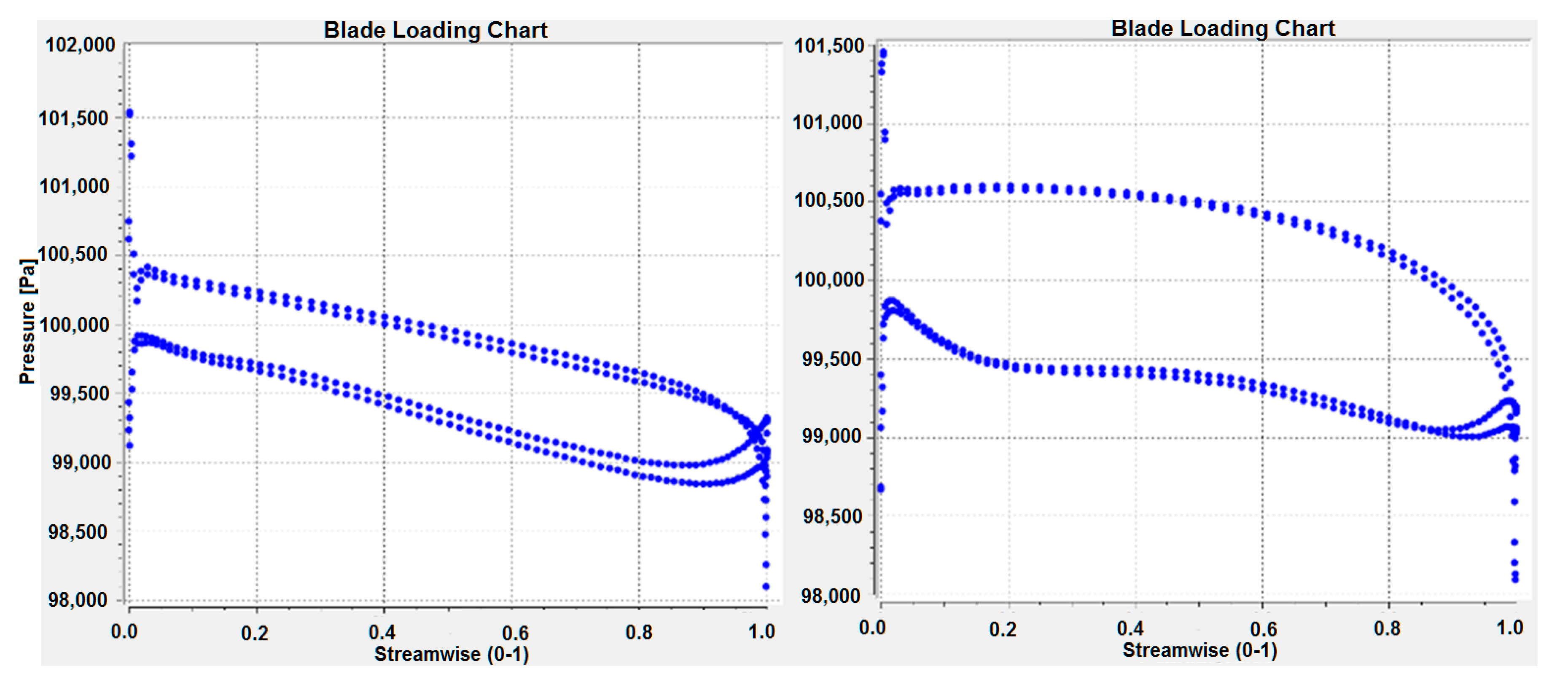
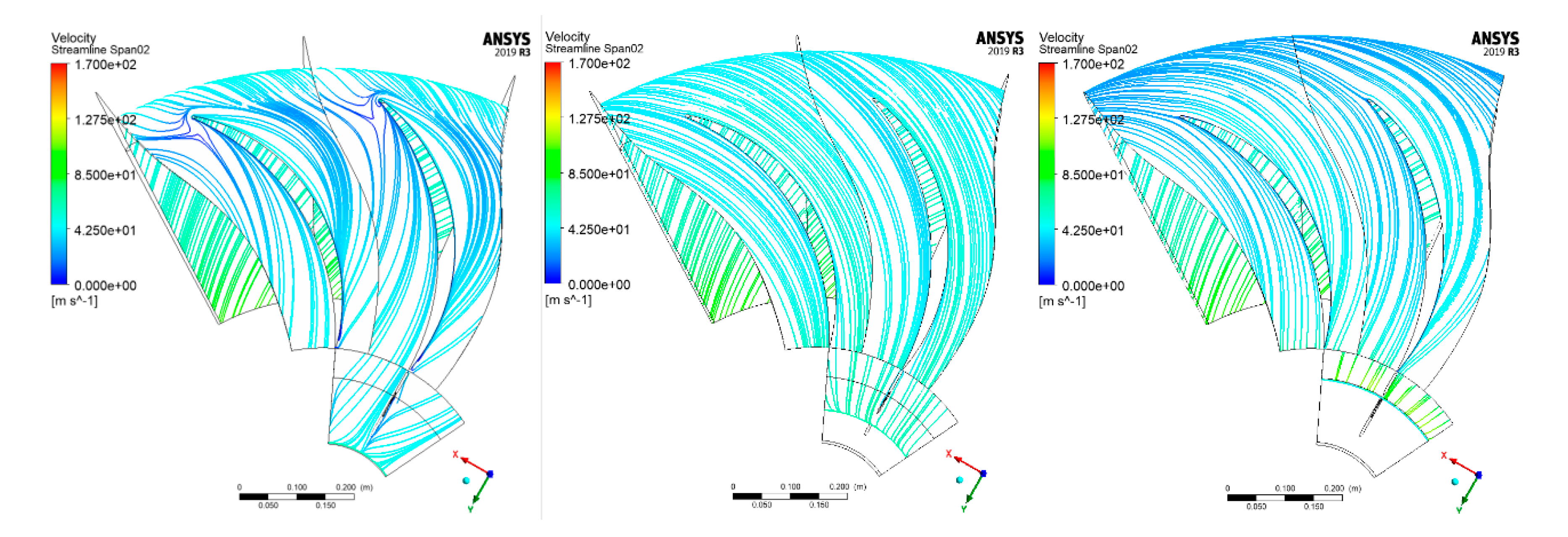


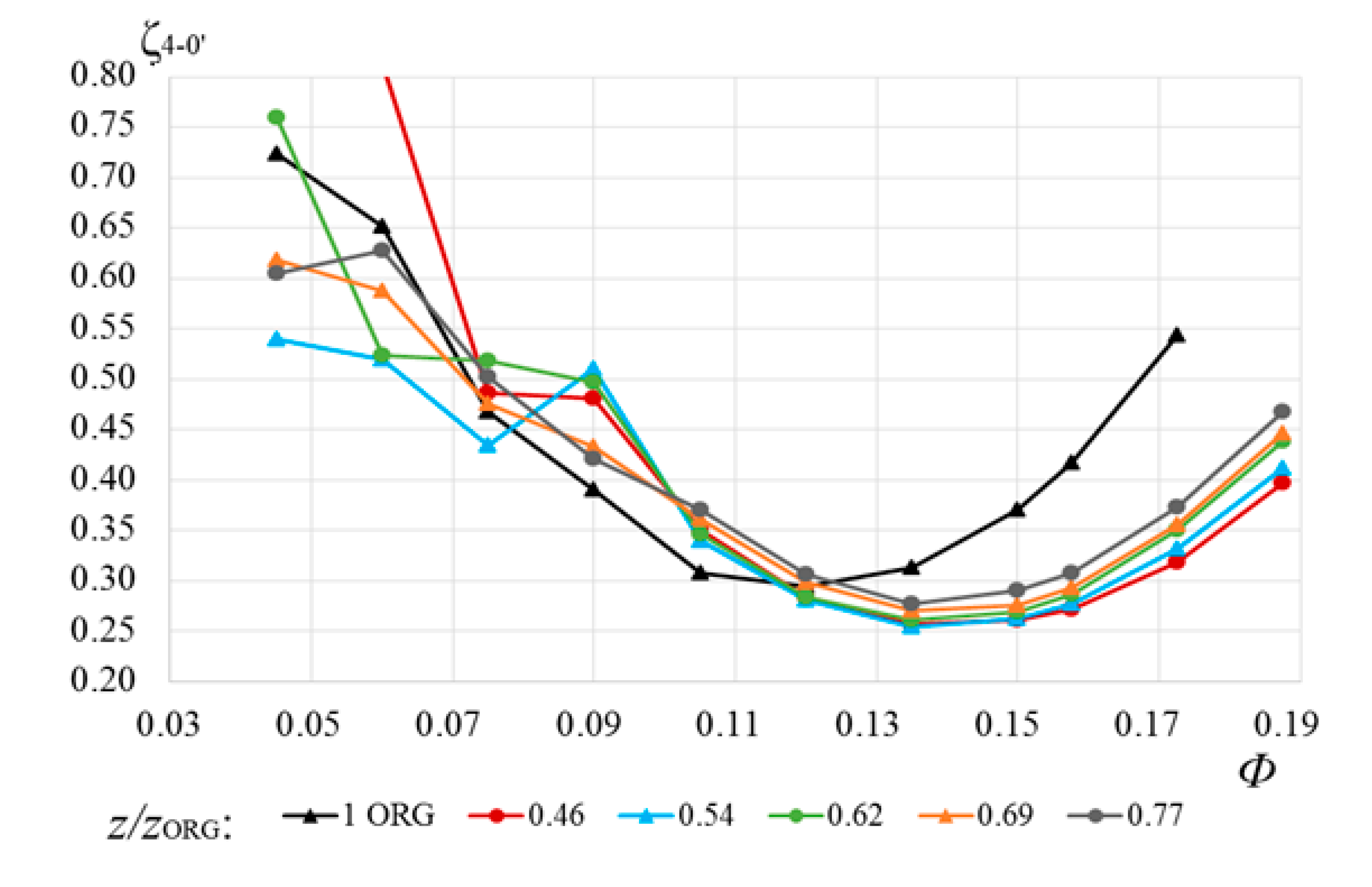





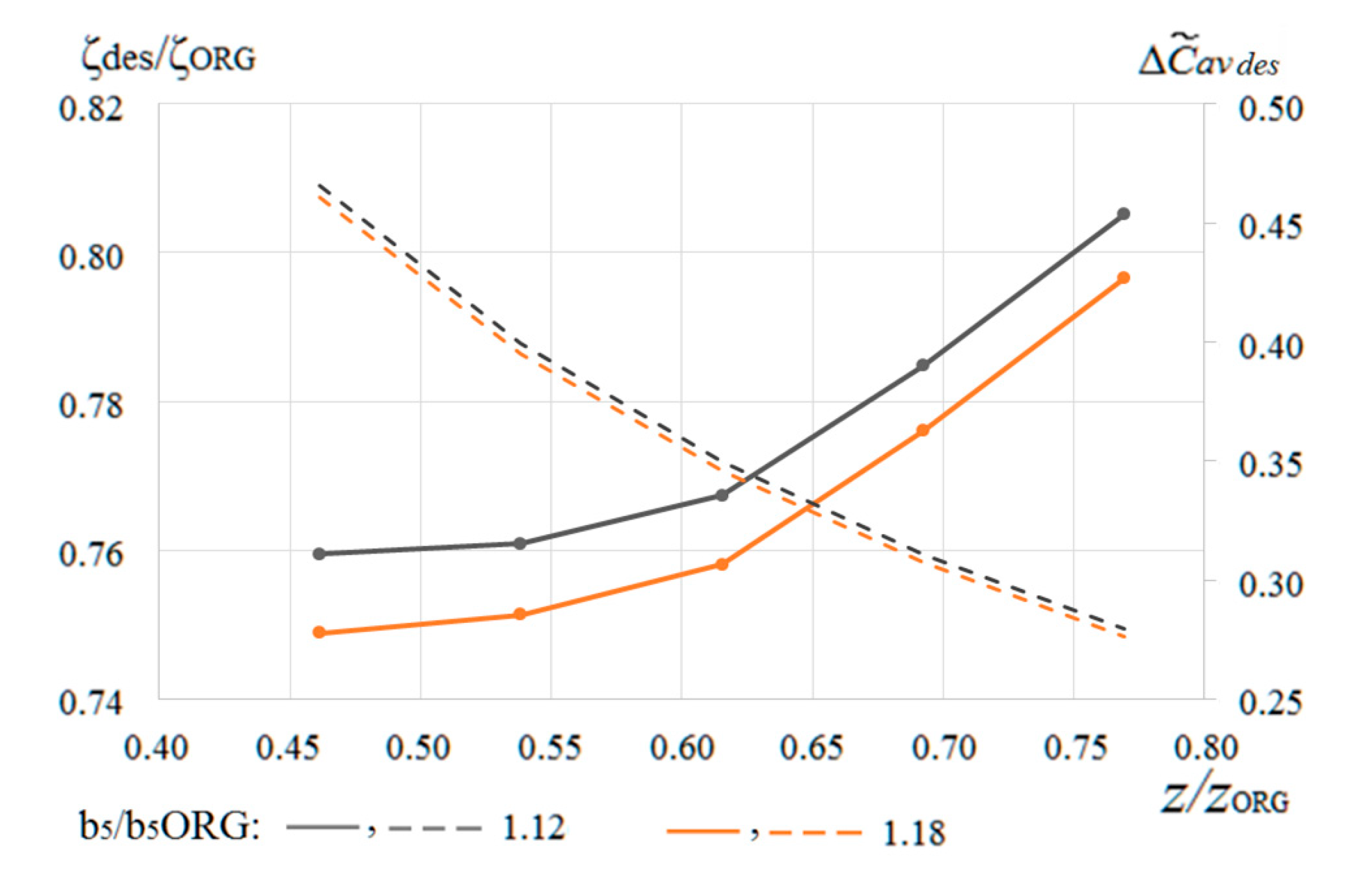
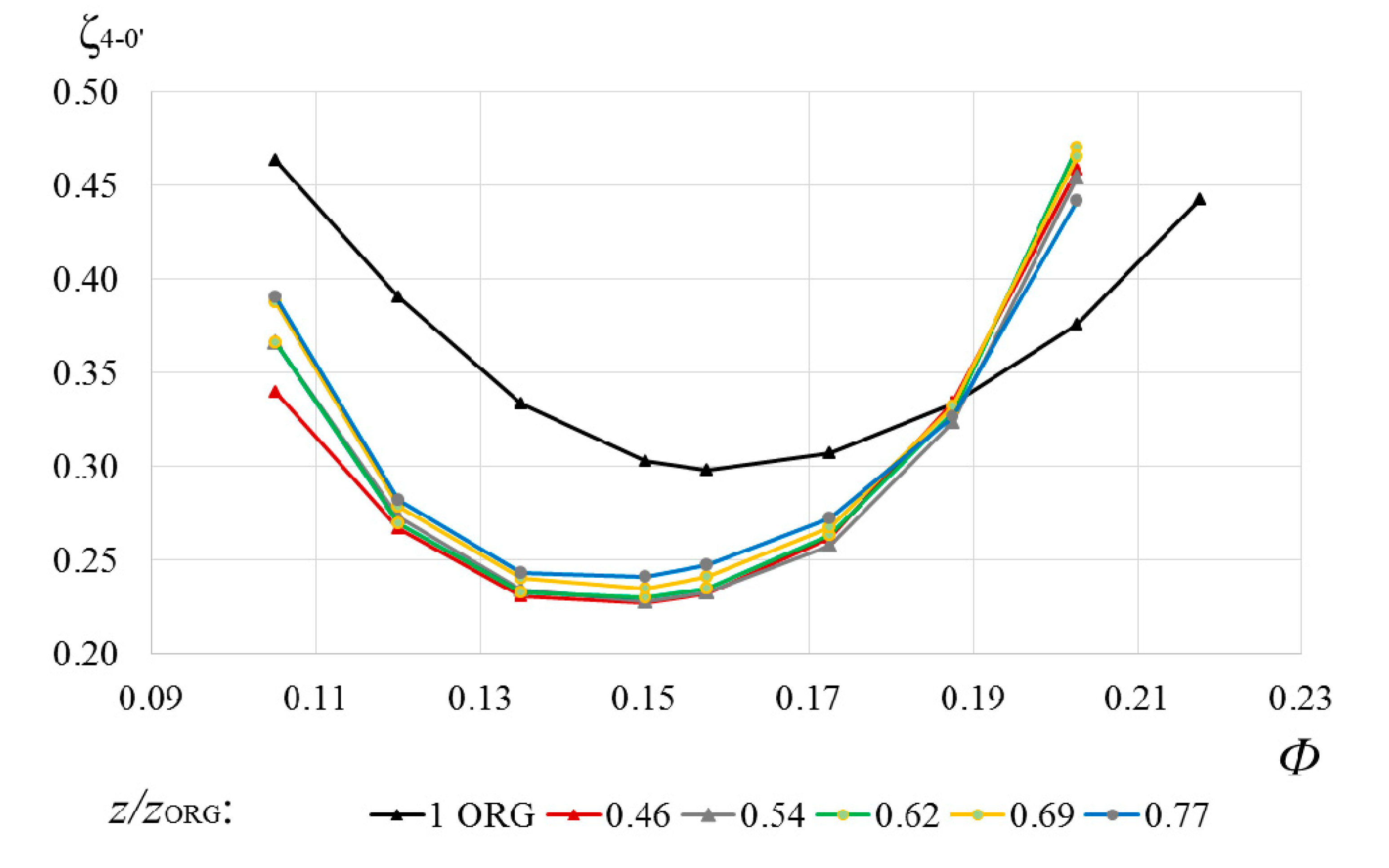

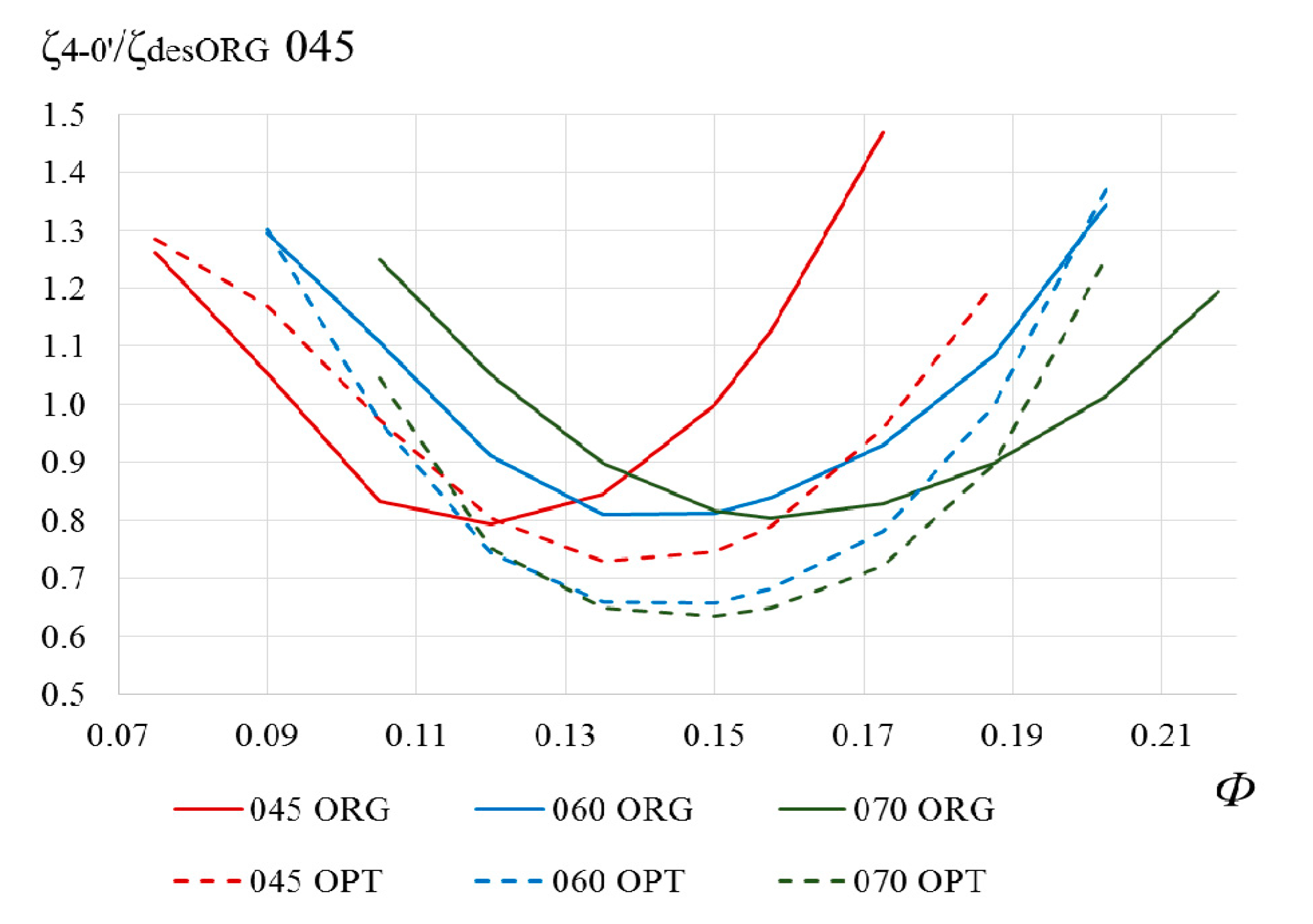

| # | Stage | |||||||
|---|---|---|---|---|---|---|---|---|
| 1 | 3D + VLD | 0.1500 | 0.7219 | 1.7064 | 0.3500 | 0.6000 | 2.930 × 1007 | 0.8158 |
| 2 | 3D + VLD | 0.1203 | 0.6803 | 1.7064 | 0.3500 | 0.6000 | 3.650 × 1007 | 0.8652 |
| Compressor efficiency | 0.8391 | |||||||
| RPM, 1/min | 2749.07 | |||||||
| Power consumption, kW | 7302.16 | |||||||
| Tip speed, m/s | 245.62 | |||||||
| Body volume, m3 | 32.99 | |||||||
| = | 0.791 | 0.879 | 0.904 |
| / | 1.226 | 1.226 | 1.226 |
| / | 1.356 | 1.220 | 1.179 |
| 1.95 | 1.95 | 1.95 | |
| 0.064 | 0.086 | 0.099 |
Publisher’s Note: MDPI stays neutral with regard to jurisdictional claims in published maps and institutional affiliations. |
© 2020 by the authors. Licensee MDPI, Basel, Switzerland. This article is an open access article distributed under the terms and conditions of the Creative Commons Attribution (CC BY) license (http://creativecommons.org/licenses/by/4.0/).
Share and Cite
Galerkin, Y.; Rekstin, A.; Marenina, L.; Drozdov, A.; Solovyeva, O.; Semenovskiy, V. Optimization of Return Channels of High Flow Rate Centrifugal Compressor Stages Using CFD Methods. Energies 2020, 13, 5968. https://doi.org/10.3390/en13225968
Galerkin Y, Rekstin A, Marenina L, Drozdov A, Solovyeva O, Semenovskiy V. Optimization of Return Channels of High Flow Rate Centrifugal Compressor Stages Using CFD Methods. Energies. 2020; 13(22):5968. https://doi.org/10.3390/en13225968
Chicago/Turabian StyleGalerkin, Yuri, Aleksey Rekstin, Lyubov Marenina, Aleksandr Drozdov, Olga Solovyeva, and Vasiliy Semenovskiy. 2020. "Optimization of Return Channels of High Flow Rate Centrifugal Compressor Stages Using CFD Methods" Energies 13, no. 22: 5968. https://doi.org/10.3390/en13225968








